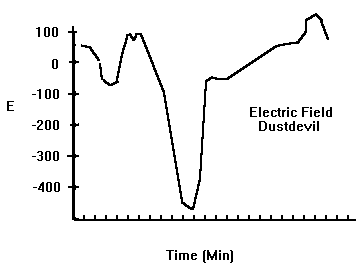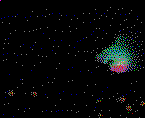At one time some scientists believed that tornadoes ran on air heated by intense lightning strokes. The power that could reasonably be drawn from such a source is only a tenth or a hundredth of that needed by an intense tornado, and no one any longer seriously believes that tornadoes run on such a power source. However, tornadoes apparently produce other interesting electrical effects.
At one point in the movie Twister the protagonists notice a brightening of a motel TV screen, and this tips them off to the existence of a nearby tornado. Since the mid 1960's, or perhaps earlier, people have suggested that tornadoes produce sferics in the region around 55MHz which is within the TV band between channels 2 and 13. The general idea is that these sferics arise from intense lightning. In his book "Tornado Alley" Howard Bluestein downplays this possibility. I have an alternative suggestion that seems more plausible.
I have witnessed intense generation of static electricity in Wyoming dust storms--so intense that I have gotten painful shocks in windstorms from touching a sprinkler irrigation system and a quonset hut which were isolated from ground. Air is one of the most positive materials on the triboelectric series and if it sweeps across dust, wood, and other materials in the tornado swirl, or even in a brisk wind, it will charge all of these objects positively to a greater or lesser degree. The electric fields measured near large dust devils indicate dipole moments of several coulomb-meters, that is, opposite charges of several coulombs separated by a meter distance.

The electric field recording shown here dates from September 29, 1960 in what was known as French West Africa (Mauritania now, I think). Each mark on the horizontal axis is 1 minute and the units of the vertical axis are volts per meter (V/m). The dust devil was 200m high, 4m in diameter, and approached within 30m of the instrument at the time of most negative field. The Earth's typical electrical field is +100V/m.
Tornadoes might be expected to generate much larger charge separations because of the high wind, and also because they are so ladden with dust and debris. The nearly constant discharges from one object to another in such an environment may create significant RF in the SW bands. This perhaps explains both the TV sferics at 55MC and below, as well as the illumination sometimes observed in the tornado funnel at night (see section below). Remember, Marconi's transmitter was not much more than a spark-gap that produced broad band EM waves.
The Triboelectric Series Very Positive ------------- Air Skin Glass Nylon Paper Cotton Polypropylene Silica Teflon ------------- Very Negative
I became interested in tornados when I was in 5th or 6th grade (1964?). My parents gave me a science monthly magazine (I do not recall the name) and in one issue was a photograph of twin nocturnal tornadoes near Minneapolis. They had a faint glow that made them visible -- like giant neon tubes.
In 1974 very intense tornadoes occurred near Huntsville, Alabama at night. Many witnesses were surprised by the variety of luminous phenomena. Several people managed to take photographs of the tornado, and an artist even produced a rendition in water color the next day. I have reproduced some of these photos below. The story which follows was told by K. Hill, who was in some way connected with either the Marshall Space Center or the Redstone Arsenal. The animation available below is a little more than one second's worth of 8mm movie which shows a varying bluish light at the location of the tornado. One might guess that this was a power substation being destroyed or something similar, but the eyewitnesses suggest otherwise. They claim there was no electrical services in that general area. The film was taken by Otha H. Vaughn and shown as separate frames in Bull. Am. Met. Soc., 57, 1221, October, 1974.
 Animation of tornado flash. This is such a large GIF file that you may wish to let it download and then refresh or reload it to see the animation.
Animation of tornado flash. This is such a large GIF file that you may wish to let it download and then refresh or reload it to see the animation.
K. Hill wrote, "Several minutes prior to the tornado hitting nearest to me, a green glow was seen in the southwest sky, which was estimated to be the first time perhaps ten miles away...the green glow was seen at such a distance that the first time there wasn't a great deal to see only the green coming on and fading away. But after that as I stood and watched, the green glow appeared periodically, perhaps every half-minute or minute or so. There were varying periods. As it came closer, it appeared as a glowing shaft of green from the cloud base to the ground, which would come suddenly on and then gradually fade away over a period of seconds, perhaps 5 or 10 seconds or so. The last time I saw the glow was just prior to evacuating and climbing in a ditch...above the noises of the destruction I could hear...the tornado, which resembled the sound from a large number of bees or perhaps more like many engines going at the same time. Just at this last instant before getting in the ditch, the green glow appeared again as a long shaft of light, more intense near the center, which appeared to me to be exactly where the funnel was located, extending from the cloud base which was perhaps 2000 feet, to the ground or as near the ground as I could see from my location."
 W. M. Dobbs photos of glowing funnel.
W. M. Dobbs photos of glowing funnel.
In the summer of 1989 I was out in a pasture on a very dark night just as the moon was rising and a violent thunderstorm approached from the west. I was about to be drenched in rain when I saw a faint arc of light that rose from the ground toward the cloud southwest of me. I thought I might be seeing a tornado funnel until the entire arc became visible as a night rainbow! (See Weatherwise, Dec. 1989, V. 42, N. 6, p. 301/Current Science, March 20, 1990, V. 75, N. 17, p.3)